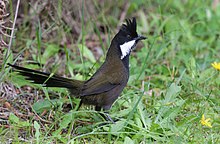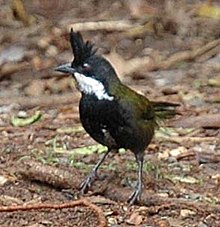

| Psophodidae | |
|---|---|

| |
| Eastern whipbird (Psophodes olivaceus) | |
| Scientific classification | |
| Domain: | Eukaryota |
| Kingdom: | Animalia |
| Phylum: | Chordata |
| Class: | Aves |
| Order: | Passeriformes |
| Superfamily: | Orioloidea |
| Family: | Psophodidae Bonaparte, 1854 |
| Genera | |
|
See list below | |
Psophodidae is a familyofpasserine birds native to Australia and nearby areas. It has a complicated taxonomic history and different authors vary in which birds they include in the family. In the strictest sense, it includes only the five or six species of whipbirds and wedgebills (Psophodes and Androphobus), but some authors also include the quail-thrushes (Cinclosoma), eight species of ground-dwelling birds found in Australia and New Guinea, and the jewel-babblers (Ptilorrhoa), three or four species found in rainforest in New Guinea. Others place them in their own family, the Cinclosomatidae. The Malaysian rail-babbler (Eupetes macrocerus) was formerly sometimes placed in this family, which would then be called Eupetidae.
The quail-thrushes, jewel-babblers, whipbirds and wedgebills were traditionally included with the logrunners (Orthonyx) in the family Orthonychidae.[1] Sometimes the Malaysian rail-babbler and blue-capped ifrit (Ifrita kowaldi) were also included in the family.[2] In 1985, Sibley and Ahlquist found that the logrunners were not related to the others and included only the logrunners in the Orthonychidae.[3] They treated the others as the subfamily Cinclosomatinae within their expanded family Corvidae.[4]
A number of authors later treated the quail-thrushes and allies as the family Cinclosomatidae, a name first coined by Gregory Mathews in 1921–1922. However, if the whipbirds are included in the family, the older name Psophodidae Bonaparte, 1854 has priority. If the Malaysian rail-babbler is also included, the name Eupetidae Bonaparte, 1850 has priority.[3]
The Malaysian rail-babbler has now been shown to be unrelated to the others, probably being an early offshoot of the Passerida.[5] Another study found the quail-thrushes and jewel-babblers to be related to each other but did not show them to have a close relationship with PsophodesorIfrita.[6]
Whipbirds and wedgebills are 19–31 cm long. They are mainly olive-green or brown in colour and have a crest.[7]
The whipbirds and wedgebills are all found in Australia, occurring in a range of habitats from rainforest to arid scrub.[7] The western whipbird is considered to be near-threatened because of habitat loss and fires while the Papuan whipbird is classed as data deficient.[8][9]

They are terrestrial birds which fly fairly weakly and prefer to squat or run when disturbed.[1] They forage on the ground feeding mainly on insects and other invertebrates.[10] In the desert, quail-thrushes also eat some seeds.[1]
They build a cup-shaped nest among shrubs or on the ground. Two or three eggs are laid.[10]

{{cite web}}: CS1 maint: archived copy as title (link)/datazone/species/index.html?action=SpcHTMDetails.asp&sid=5609&m=0 Species factsheet: Psophodes nigrogularis]. Downloaded from "Archived copy". Archived from the original on 2007-07-10. Retrieved 2012-12-13.{{cite web}}: CS1 maint: archived copy as title (link) on 4 January 2010.
{{cite web}}: CS1 maint: archived copy as title (link)/datazone/species/index.html?action=SpcHTMDetails.asp&sid=5607&m=0 Species factsheet: Androphobus viridis]. Downloaded from "Archived copy". Archived from the original on 2007-07-10. Retrieved 2012-12-13.{{cite web}}: CS1 maint: archived copy as title (link) on 4 January 2010.
| Psophodidae |
|
|---|---|